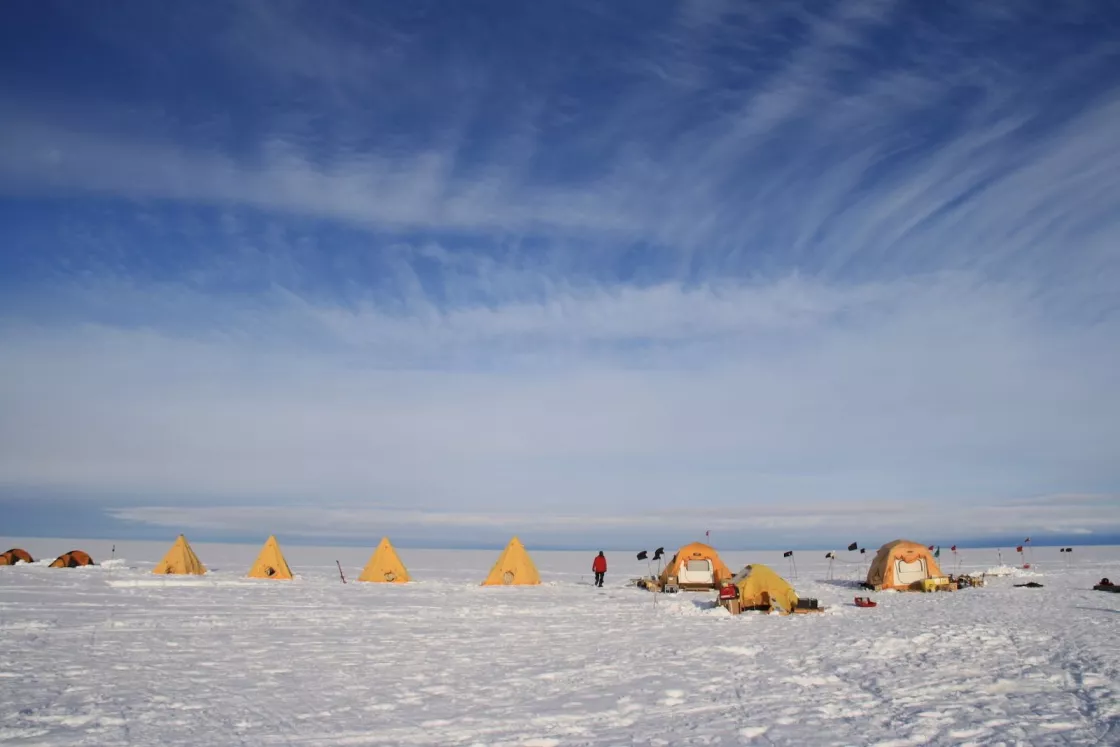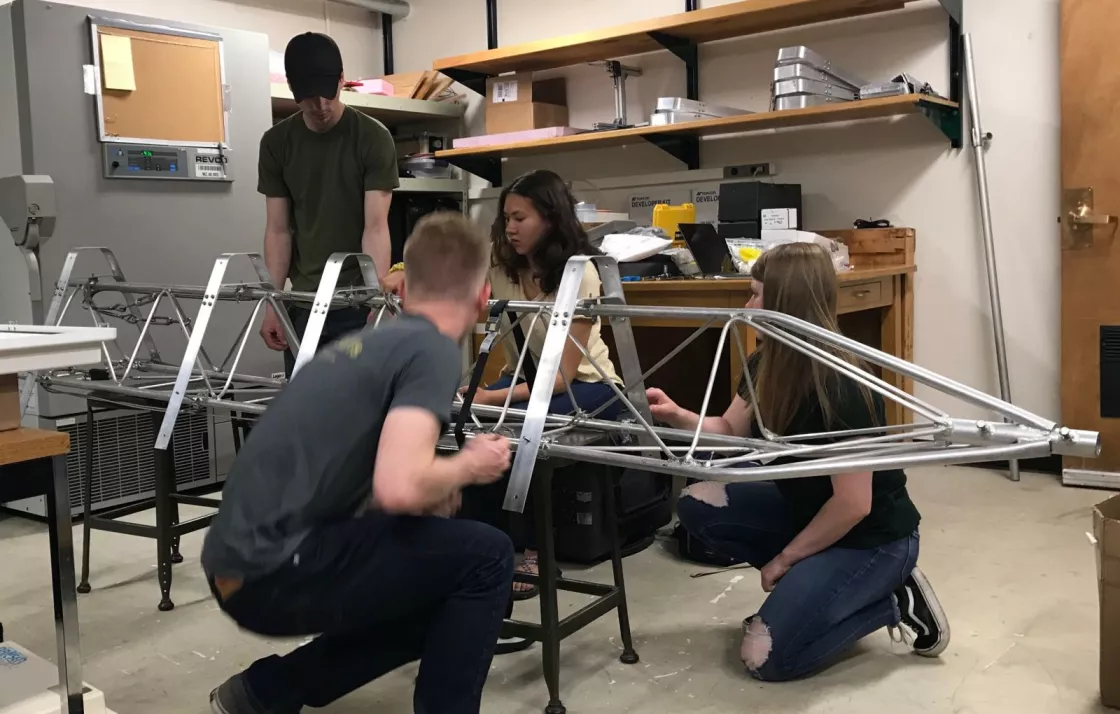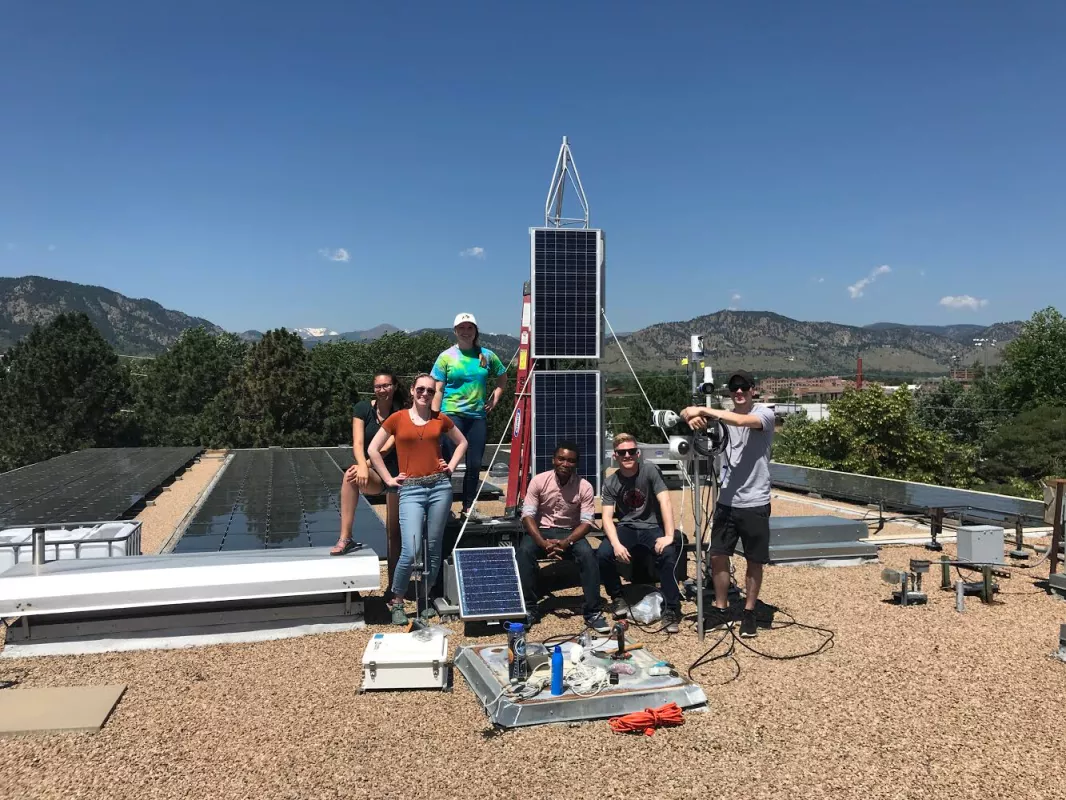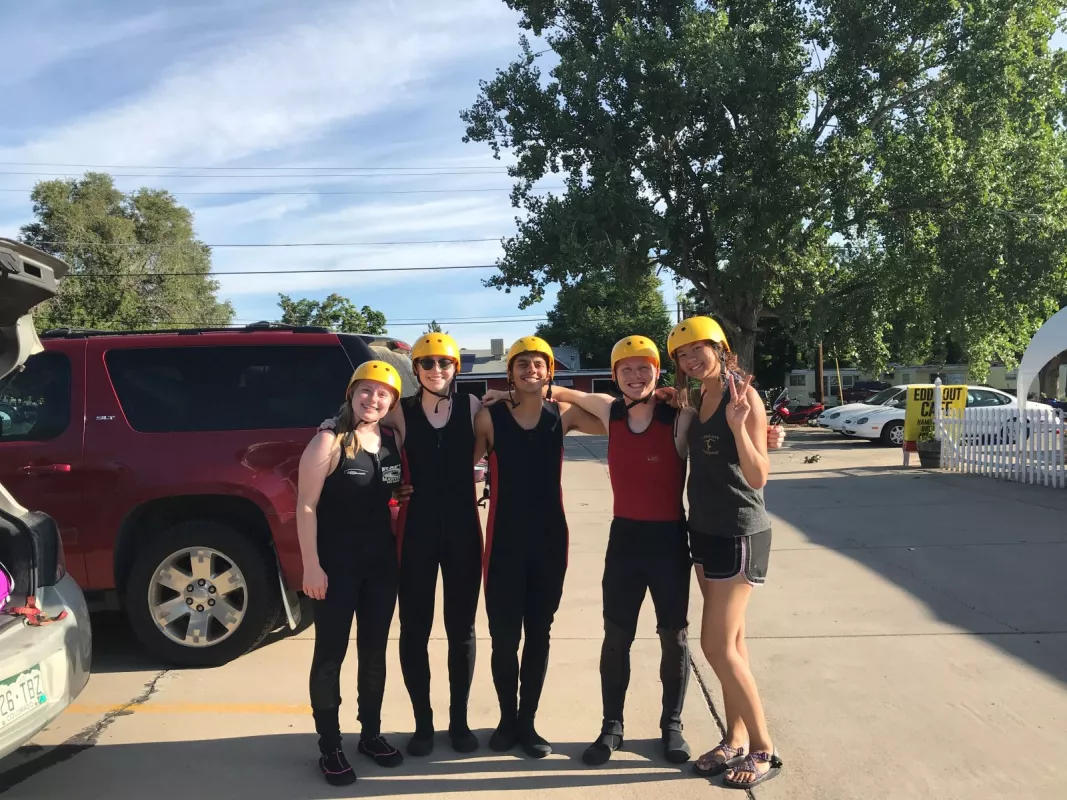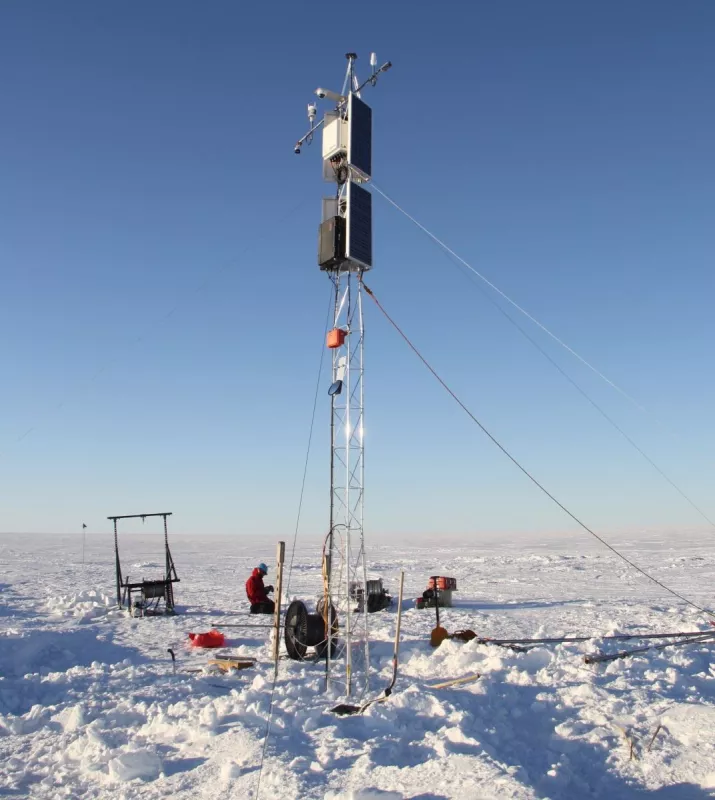By Audrey Payne
Seven engineering students walked into a bagel shop. Rather than discuss lab assignments or upcoming exams, the students turned to more dire topics of conversation. They brainstormed solutions for understanding a massive glacier and how its contribution to sea level rise will impact their generation.
This diverse group of students from the University of Colorado (CU) Boulder included both men and women and representatives from the sophomore, junior, and senior classes. Raymie Fotherby, Ryan Weatherbee, Emma Tomlinson, Sid Arora, Coovi Meha, Skylar Edwards, and Jack Soltys spent a year working as part of the Thwaites-Amundsen Regional Survey and Network (TARSAN) project team for the International Thwaites Glacier Collaboration (ITGC). ITGC is a joint United States and United Kingdom mission to study Antarctica’s Thwaites Glacier, the surrounding ocean system, and its future contribution to global sea level.
Thwaites Glacier in West Antarctica is massive. It covers 192,000 square kilometers (74,000 square miles)—an area the size of Florida or Great Britain. It is rapidly losing mass in response to climate change and related changes in ocean circulation. Scientists expect this rate of ice loss to accelerate and fear that a run-away collapse of the glacier will lead to an increase in global sea levels of up to 65 centimeters, or two feet, in the coming centuries, putting coastal cities and communities around the world at risk. To put it in perspective, about 40 percent of the planet’s population live within 100 kilometers (60 miles) of the coast, and significant sea level rise could imperil eight out of ten of the world’s largest cities, including Tokyo, Mumbai, New York City, Shanghai, Lagos, Los Angeles, Calcutta, and Buenos Aires, according to the United Nations Atlas of the Oceans. For these reasons, ITGC seeks to answer two paramount questions: how much could Thwaites Glacier contribute to sea level rise, and how soon?
The TARSAN project team, of which the seven undergraduate CU students are a part, is studying how atmospheric and oceanic processes are influencing the behavior of Thwaites Glacier and nearby Dotson Ice Shelf. The two neighboring ice shelves are behaving differently, with Dotson Ice Shelf considered to be more stable than Thwaites Glacier. This research will help identify how variations in atmospheric or oceanic conditions may influence the stability of ice shelves in the region.
Creating the team
Ted Scambos, a polar scientist at the Cooperative Institute for Research in Environmental Sciences (CIRES) at CU Boulder, is one of about 60 scientists and staff who have conducted research in Antarctica during the second field season of ITGC. In addition to being ITGC’s lead scientific coordinator for the United States, he is also a co-investigator on the TARSAN project.
“With TARSAN, we are trying to follow the water as it goes from the open ocean to under the floating ice and out again,” said Scambos. “This is a new path for the deep ocean—one that the deep warm water did not follow very often before 1970. Now, it is wearing away at the base of the ice, loosening it, and making it speed up.”
When Scambos needed assistance with technical aspects of the project, he turned to the resources available on campus—the students. He reached out to the Colorado Space Grant Consortium, a NASA-funded organization that provides Colorado students with experiences in space engineering to prepare them for our nation’s future space programs. Soon after, the Junior Antarctic Engineering team (JANE) was born.
Team JANE was named as a compliment to TARSAN and in reference to the legendary jungle man’s love interest. Each of the Team JANE students were hired through the consortium. They committed to an allotted amount of time on the project—some just for a semester, some for the entire year.
“This was such a cool opportunity because we don’t get a lot of chances to do engineering that matters,” said Weatherbee, a senior at CU Boulder and seemingly the leader of the pack. “This project will be used for something real rather than something that will just be graded and tossed. To see it applied to real science and research is really neat.”
Getting to work
Thwaites Glacier is extremely remote and virtually inaccessible for parts of the year. Therefore, to obtain continuous data on the atmospheric and oceanic conditions, scientists need a system that can be set up and then left behind on the ice to continue collecting data, which is then sent automatically back to the lab at the National Snow and Ice Data Center (NSIDC) in Boulder, Colorado, via satellite phone. This system, now in its third rendition, is known as the Automated Meteorology-Ice Geophysics-Ocean System (AMIGOS); it has been used, tested, and updated in Antarctica since 2009 when Scambos and a team of scientists first deployed it to study the Larsen Ice Shelf for a National Science Foundation project. AMIGOS is designed to run year-round: nine months with a full data collection suite, and a shortened data routine during polar winter to conserve battery power.
The JANE students built three AMIGOS systems, each costing $160,000, which were assembled by the TARSAN team on Thwaites Glacier and the Dotson Ice Shelf. They essentially equipped three solar stations with sensors and monitors to measure a variety of factors both on the ice and in the ocean, such as temperature, snow height, wind, pressure, ocean currents, and ocean salinity. Those that take ocean measurements were lowered 1,600 meters (about a mile) through boreholes in the ice.
“The most challenging aspect was understanding the full scope of the project and how it was all going to work together,” said Fotherby, another senior engineering student. “I could understand pieces, but sometimes figuring out how it was going to work with another sub-system or within the overall architecture of the system was difficult.”
The students worked on every aspect of the project together—communicating with Scambos about his needs, familiarizing themselves with each of the many systems used in the project, writing code, and putting the towers and the sensors together.
“For me, the most challenging part of the project was getting familiar with all the systems that the scientists were using,” said Tomlinson, Fotherby’s roommate. “We used Python and Linux a lot and I did not understand them well at first, but having deadlines to figure that kind of stuff out was a huge learning experience for me.”
Building new skills, together
When the students hit a roadblock or saw an unmet need, they found a solution. For example, the scientists on the project wanted to send a GoPro camera down the borehole to the ocean to check the smoothness of the hole and have a look at the seabed below, but they needed a pressure vessel to carry the GoPro and a long-life battery to ensure the camera could operate for the desired length of time. The vessel had to be strong enough to survive 2,500 pounds per square inch (psi) of water pressure. The students took it upon themselves to utilize the machine shop on campus, learn the necessary skills, and assemble the pressure vessel from carefully machined parts, even though many of them had no prior experience with this type of project. Weatherbee, who had a fair amount of machining experience, mentored his teammates and spent nearly 100 hours working on the vessel.
“Getting to know people who are interested in the same things and getting to work beside them on this project was so valuable,” said Arora, who was only a freshman when the project began. “Everyone on the team was so willing to help with every aspect. Ryan [Weatherbee] took us to his backyard to teach us to use a blowtorch because no one else knew how.”
Once the pressure vessel was built, Fotherby took the lead on this aspect and sent it off to be tested in a high-pressure chamber at the University of Washington in Seattle. The vessel had to be tested three times, each time learning from new problems and solving them. On the first two tries, the vessel did not hold up under pressure, but the third time was the charm—with only a tiny leak, the unit passed the test and was dispatched the Antarctica.
From colleagues to friends
While most of the students did not know each other at the beginning of the project, by the end they became fast friends.
“I really appreciated how interdisciplinary the project was,” said Weatherbee. “There were so many different types of challenges within—we built electrical, mechanical, software skills—and each person brought something different to the project. They all related really well.”
In addition to meeting to talk shop, they began holding Friday night dinners, had a standing date at Moe’s Bagel Shop for lunch on Thursdays, and even went whitewater rafting together.
“This has been a year-long relationship-building opportunity,” said Arora.
This field season, which is the second of four for ITGC, takes place from November 2019 to March 2020 and includes two legs: the first, which included on-the-ground research on Thwaites Glacier and Dotson Ice Shelf, and the second, in which researchers will investigate the ocean near the glacier via a research cruise. Team JANE’s towers and pressure vessel were used for research during the first leg. The towers were installed on both the glacier and the ice shelf, where they will remain to collect data even as the scientists return to civilization.
“This project has opened so many doors,” said Arora. “The more I worked on this project, the more I’m thinking of doing oceanic or atmospheric research. Ted [Scambos] has so many contacts and has been so helpful. It’s really opened my mind to possibilities beyond my major.”
